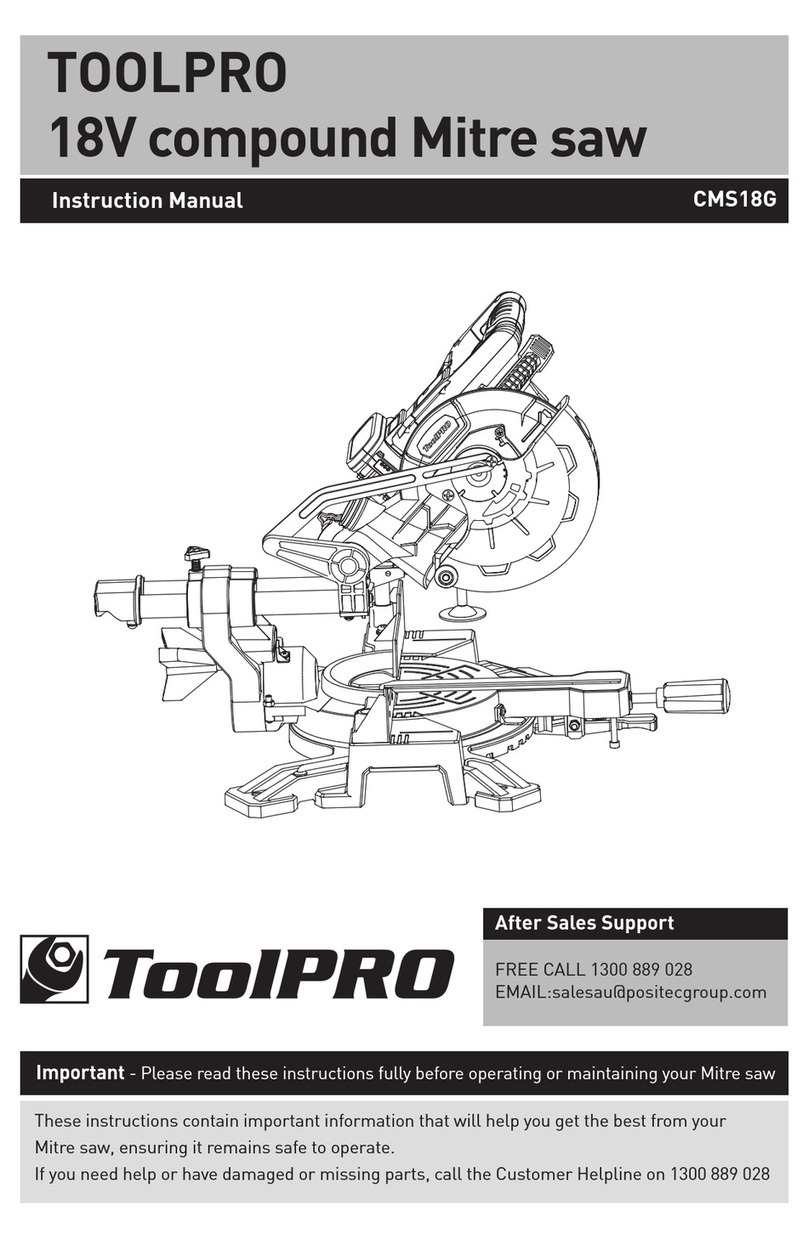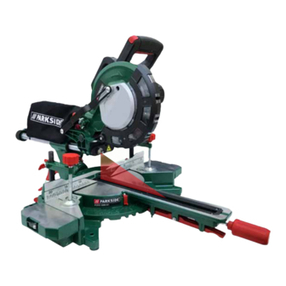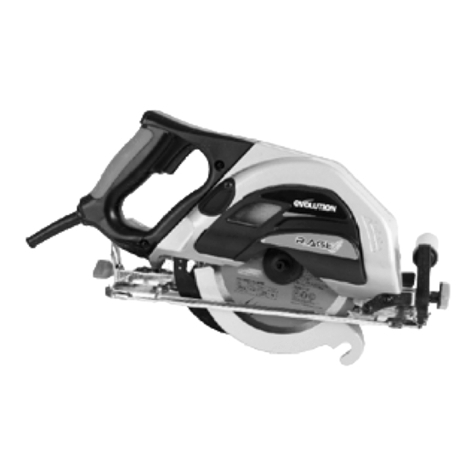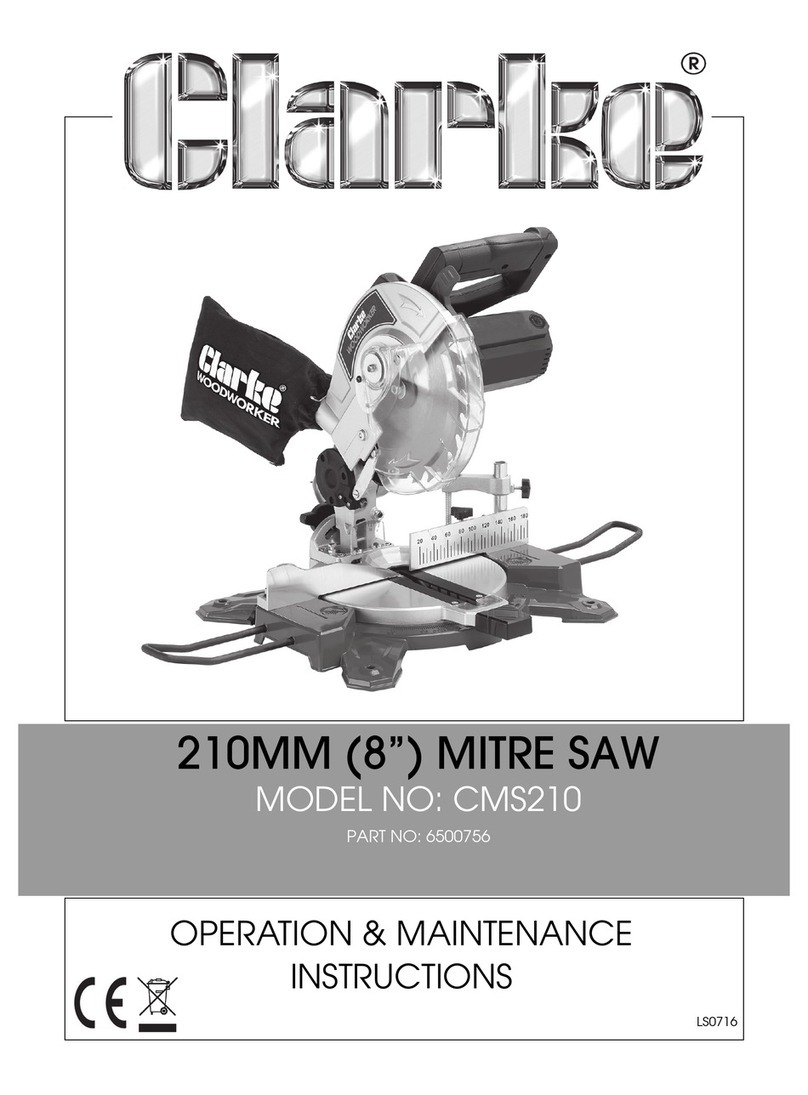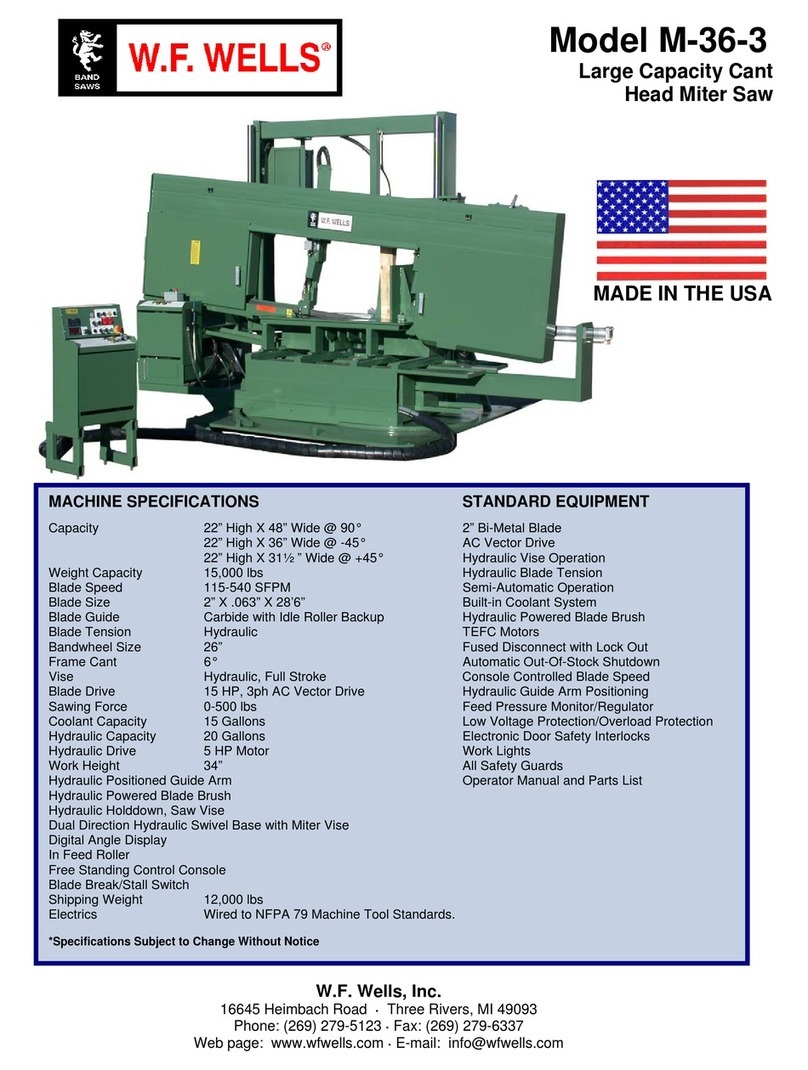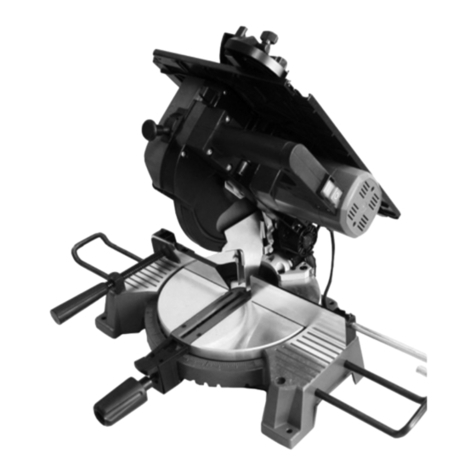ToolPRO HM80L User manual

HM80L Undercut Mitre Saw
Instruction Manual
PLU XXXXXX

Fig. 1
1
2
9
6
7
11
3
8
5
13
4
12
10
Fig. 2
2
1
14
8
Fig. 1.2
31
32
27
Fig. 3
23 24
25
Fig. 4
1
9
30
14
2

Fig. 6
16
Fig. 5
3
4
11
AUS Caution - Read the operating instructions to reduce the risk of inquiry
AUS Wear safety goggles!
AUS Wear ear-muffs!
Explanation of the symbols on the equipment
AUS Protection class II

4 Customer Helpline 1300 858 645
MANUFACTURER:
Made in China
DEAR CUSTOMER,
we wish you a pleasant and successful working experi-
ence with your new machine.
According to the applicable product liability law the man-
ufacturer of this device is not liable for damages which
arise on or in connection with this device in case of:
• improper handling,
• non-compliance with the instructions for use,
• repairs by third party, non authorized skilled workers,
• installation and replacement of non-original spare parts,
• improper use,
• failures of the electrical system due to the non-com-
pliance with the electrical specications and the
VDE 0100, DIN 57113 / VDE 0113 regulations
Recommendations:
Read the entire text of the operating instructions prior to
the assembly and operation of the device.
These operating instructions are intended to make it
easier for you to get familiar with your device and utilize
its intended possibilities of use.
The operating instructions contain important notes on
how to work safely, properly and economically with your
machine and how to avoid dangers, save repair costs,
reduce downtime, and increase the reliability and work-
ing life of the machine.
In addition to the safety regulations contained herein,
you must in any case comply with the applicable regula-
tions of your country with respect to the operation of the
machine.
Put the operating instructions in a clear plastic folder to
protect them from dirt and humidity, and store them near
the machine. The instructions must be read and care-
fully observed by each operator prior to starting the work.
Only persons who have been trained in the use of the
machine and have been informed on the related dangers
and risks are allowed to use the machine. The required
minimum age must be met.
In addition to the safety notes contained in the present
operating instructions and the special regulations of your
country, the generally recognized technical rules for the
operation of wood working machines must be observed.
LEGEND, FIG. 1
1 Grip
2 Start switch
3 Base
4 Joint for casing / base
5 Rotary table
6 Motor
7 Saw blade
8 Table insert
9 Ratchet lever
10 Saw blade guard, xed
11 Saw blade guard, moveable
12 Chip bag
13 Clamping jaw
HM80L
Scope of delivery
Undercut Mitre Saw
dust collector bag
workpiece holder
tooling for sawblade change SW 6
3 supports
2 carbon brushes
Operating instructions
Technical Data
Dimensions
L x W x H mm 395 x 340 x 468
ø revolving table
mm 380 x 130
Table height mm 55
Saw blade ø mm 210/30/2,6/1,6 WZ 30
Speed 1/min 5000
Cutting rate m/s 55
Swivel range 2 x 45°
Tool cutting edge
inclination 45°
Doublemitering
45º x 45º left
Adjustments 45°, 30°, 22,5°, 15°, 0°,
15°, 22,5°, 30°, 45°
Weight kg 7,7
Cut data for rip cutting
90°/90°/120 x 60 mm
90°/45° 80 x 60 mm
45°/90° 120 x 35 mm
45°/45° 80 x 35 mm
Drive
Motor V/Hz 220-240 ~ 50
Input W S6 25% 1500W
Subject to technical modications!
The height of the workpiece must be at least 3 mm.
Make sure that the workpiece is always secured with the
clamping device.
Information on noise
The noise levels of the machine during operation are as
follows:
LpA: 99.6dB(A) K=3dB(A)
LwA: 112.6dB(A) K=3dB(A)
Vibration: 4.51m/s2 K=1.5m/s2
Warning: Noise can seriously damage your health. If the
engine noise exceeds 85 dB (A), please wear appropria-
te hearing protection. If the electrical connection is faulty,
the current may drop when the machine starts. This may
affect other machines (e.g. ashing lights). If the elec-
tric output corresponds to Zmax <0.27, such interference
should not occur. (If it does, notify your dealer).
• The vibration emission value given below has been
measured by a standardized test, and can be used
for comparing one power tool to another;
• The vibration emission value given below may also be
used for a rst assessment of exposure.
Warning:
• The vibration emission value may vary during ac-
tual use of the power tool from the specied value,
depending on the manner in which the power tool is
used;

5
Customer Helpline 1300 858 645
• Try to keep exposure to vibration to a minimum. Ex-
amples of ways to reduce vibration levels are wearing
gloves when using the tool and limiting working hours.
In doing so, all parts of the operating cycle must be
taken into account (for example, times in which the
power tool is turned off, or when it is turned on with-
out load).
General notes
• After unpacking, check all parts for any transport dam-
age. Inform the supplier immediately of any faults.
• Later complaints cannot be considered.
• Make sure the delivery is complete.
• Before putting into operation, familiarize yourself with
the machine by carefully reading these instructions.
• Use only original SCHEPPACH accessories, wearing
or re place ment parts. You can nd replacement parts
at your SCHEPPACH dealer.
• When ordering, include our item number and the type
and year of construction of the machine.
In these operating instructions we have marked the
places that have to do with your safety with this
sign: m
mGeneral Safety Notes
• Provide adequate lighting in the workplace.
• Use the clamping device to secure the workpiece.
• Follow the instructions for changing tools.
• Keep handles dry and free from oil and grease.
• Distribute the safety instructions to all persons working
on the machine.
• Keep all safety and hazard warnings on the machine
in complete and legible condition at all times.
• Check power cords. No faulty cables.
• Make sure that the machine is stable and on solid
ground.
• Take care when working: there is risk of injury to n-
gers, hands and eyes.
• Keep children away from the machine when it is
plugged in.
• When the machine is being operated, all guards and
covers must be properly tted.
• The operator must be at least 18 years old. Apprenti-
ces must be at least 16 years old and should be su-
pervised when using the machine.
• Persons working on the machine should not be dis-
tracted.
• Keep the machine work station clear of chips and
wood waste.
• Wear tight-tting clothing. Take off jewelry, rings and
watches.
• Wear a cap or hairnet to protect long hair.
• The safety devices on the machine must not be dis-
mantled or destroyed.
• Perform retting, adjustment, measurement and
cleaning work only when the engine is turned off. Un-
plug and wait for the rotating parts of the tool to come
to a complete standstill.
• Switch off the machine when troubleshooting. Unplug
the machine.
• Installation, repair and maintenance work on the elec-
trical installation may only be carried out by qualied
professionals.
• All protective and safety equipment must be immedi-
ately re-installed after repairs and maintenance are
completed.
• Do not expose the machine to moisture and do not
use near ammable liquids or gases.
• Take care during machine operation. Use common
sense when working. Do not use the power tool when
you are tired or distracted.
• Never use outdoors when the general weather and
environmental conditions do not allow it (e.g. char-
ged atmospheres, during a lightning storm or when
it is raining).
• Wear appropriate clothing: Do not wear wide slee-
ves, scarves, neckties, necklaces, or bracelets, which
could get caught in the moving machine parts.
• Always use personal safety devices: appropriate re-
gulation goggles, well-tting gloves, outer or inner ear
protection and a hood that covers the hair if neces-
sary.
• Pay attention to the power cable: it must never catch
on the machine or cause the machine to become un-
plugged. Protect it from sharp edges, oil and over-
heating.
• If an extension cord is needed, use only approved
products.
• Guard against electric shock: avoid contact with
grounded objects such as pipes, radiators and ref-
rigerators.
• Keep your work area clean.
• Do not overload the power tool - you will work more
safely within an appropriate output range.
• Wear safety glasses and a dust mask when carrying
out work which generates dust. .
• Always connect the dust collection device every time
you work.
• Do not use the cable for purposes for which it was not
intended. Do not use it to pull the plug from the socket.
Keep the cable away from heat, oil and sharp edges.
• Avoid inappropriate body posture. Keep proper footing
and keep your balance at all times.
• Do not leave any wrenches or key tools in the machi-
ne. Before turning the machine on, make sure that ad-
justing keys and wrenches have been removed.
• Store unused power tools safely. They should be
stored in a dry place, locked or placed up high so that
they are out of reach of children.
• Use the correct power tool.
• Do not use low output machines for heavy work.
• Do not use the power tool for purposes for which it
was not intended.
• When working outdoors, non-skid footwear is recom-
mended.
• Take good care of tools. Keep cutting tools sharp and
clean for better and safer working conditions.
• Regularly check the power tool‘s power cord and have
it replaced by a certied technician if damaged.

6 Customer Helpline 1300 858 645
• Inspect extension cords regularly and replace them if
they are damaged.
• Avoid accidental starting of the machine.
• Make sure that the switch is off when plugging it into
the mains.
• Check the power tool for damage.
• Before further use of the power tool, safety devices or
slightly damaged parts should be carefully inspected
for proper and intended function.
• Verify that the moving parts work properly and do not
jam and check that there are no damaged parts. All
parts must be installed correctly and meet all requi-
rements to ensure the proper operation of the power
tool.
• Damaged safety devices or other parts must be re-
paired by an authorized dealer in accordance with re-
gulations or replaced, unless otherwise specied in
the instructions.
• Damaged switches must be replaced at a service sta-
tion.
• Do not use electric tools with switches that cannot be
turned on and off.
• ATTENTION
• The use of other service tools and other accessories
can mean a risk of personal injury.
• Your power tool should be repaired by a qualied elec-
trician.
• This power tool complies with the relevant safety regu-
lations. Repairs may only be performed by a qualied
electrician, using original replacement parts, otherwise
injury to the user may occur.
Additional safety notes for miter saws
• Do not use deformed or damaged blades.
• Do not operate the saw without guards in place.
• Replace the table insert when worn.
• The saw should only be used to cut wood, wood-like
materials and plastics.
• Use only the manufacturer‘s recommended saw bla-
des that meet the EN847-1 standard.
• Attach a dust collector to your miter saw during ope-
ration.
• Select the blades according to the material to be cut.
• Check the maximum depth of cut.
• When cutting longer pieces always use extension rails
and insert clamps or other clamping devices for bet-
ter grip.
• Wear ear protection.
• The operator station is in front of the machine.
• Use the clamping device to secure the workpiece.
• Turn off the power tool if the blade gets stuck in the
workpiece or the workpiece gets wedged.
• Warning: Do not use blades made of high speed steel.
• Keep the oor area free of loose particles such as
wood chips and cuttings.
• Make sure that the blade speed indicated on its label
is at least as high as that of the saw speed.
• Use gloves when handling saw blades and rough ma-
terials.
• Be sure to use only shims and spindle rings that are
suitable for the purpose specied by the manufacturer.
• Warning: Do not remove cuttings or other parts of the
workpiece from the cutting area while the machine is
running and the saw has not yet come to a comple-
te stop.
• Always clamp the workpiece to the saw table.
• Make sure that the machine is sitting securely before
beginning to saw.
WARNING! Noise can be harmful to your health. If a
sound level of 85dB (A) is exceeded, ear protection
must be worn.
Before each use, all guards
and other parts should be carefully inspected to
see whether they still fulll their functions.
Check for alignment, smooth operation, breakage
or other damage that could impair function. A
damaged part should either be immediately and pro-
fessionally repaired or replaced.
m Hazard from blocking workpieces or parts thereof!
If blockage occurs, please proceed as follows:
1. Switch the device off
2. Unplug it
3. Wear gloves
4. Correct the blockage with appropriate tools.
Additional safety instructions for laser light
The laser light and laser radiation used in this system
comply with class 1 and a maximum performance of 390
μW and 650 nm wave length. Normally laser does not
represent an optical danger, although staring into the
beam can cause ash blinding.
Warning: Do not look directly into the laser beam, since
this could represent a risk. Please observe the following
safety instructions:
• The laser may only be used and maintained in accord-
ance with the instructions of the manufacturer.
• Only point the beam onto the work piece, and never
at a person or another object.
• The laser beam must not deliberately be pointed at
persons. It must not be pointed into the eyes of a per-
son for more than 0.25 seconds.
• Always make sure that the laser beam is directed onto
a robust work piece without a reecting surface. That
means that timber and materials with a rough surface
are acceptable. Shiny, reecting plates or similar ma-
terials are not suitable for laser, since the reecting
surface could return the beam to the operator.
• Do not exchange the laser light unit for another type.
Repairs have to be conducted by the manufacturer or
an authorised specialised company.
Caution: You must only apply the regulation and adjust-
ment tools and methods described in this manual. Non-
observance can lead to dangerous radiation.
Attention: Laser radiation
Do not stare into the beam
Class 2 laser

7
Customer Helpline 1300 858 645
mProper use
CE tested machines meet all valid EC machine
guidelines as well as all relevent guidelines for each
machine.
• The machine must only be used in technically per-
fect condition in accordance with its designated use
and the instructions set out in the operating manual,
and only by safety-conscious persons who are fully
aware of the risks involved in oerating the machine.
Any functional disorders, especially those affecting the
safety of the machine, sholud terefore be rectied im-
mediately.
• Any other use exceeds authorization. The manufac-
turer is not responsible for any damages resulting from
unauthorized use; risk is the sole responsibility of the
operator.
• The safety, work and maintenance instructions of the
manufacturer as well as the technical data given in
the calibrations and dimensions must be adhered to.
• Relevant accident prevention regulations and other,
generally recognized safety-technical rules must also
be adhered to.
• The machine may only be used, maintained, and op-
erated by persons familiar with it and instructed in its
operation and procedures. Arbitrary alterations to the
machine release the manufacturer from all responsi-
bility for any resulting damages.
• The machine may only be used with original accesso-
ries and tools made by the manufacturer.
m Remaining hazards
The machine has been built using modern technolo-
gy in accordance with recognized safety rules. Some
remaining hazards, however, may still exist.
• Only process selected woods without defects such
as: Branch knots, edge cracks, surface cracks. Wood
with such defects is prone to splintering and can be
hazardous.
• Wood which is not correctly glued can explode when
being processed due to centrifugal force.
• Trim work piece to a rectangular shape, center and
correctly secure before processing. Unbalanced work
pieces can be hazardous.
• Long hair and loose clothing can be hazardous when
the work piece is rotating. Wear personal protective
gear such as a hair net and tight tting work clothes.
• Saw dust and wood chips can be hazardous. Wear
personal protective gear such as safety goggles and
a dust mask.
• The use of incorrect or damaged mains cables can
lead to injuries caused by electricity.
• Even when all safety measures are taken, some re-
maining hazards which are not yet evident may still
be present.
• Remaining hazards can be minimized by following the
instructions in „Safety Precautions“, „Proper Use“ and
in the entire operating manual.
• Do not force the machine unnecessarily: excessive
cutting pressure may lead to rapid deterioration of the
blade and a decrease in performance in terms of nish
and cutting precision.
• When cutting aluminium and plastics always use the
appropriate clamps: all workpieces must be clamped
down rmly.
• Avoid accidental starts: do not press the start button
while inserting the plug into the socket.
• Always use the tools recommended in this manual to
obtain the best results from your cutting-off machine.
• Always keep hands away from the work area when
the machine is running; before performing tasks of
any kind release the main switch button located on the
handgrip, thus disconnecting the machine.
• Always keep hands away from the work area when
the machine is running; before performing tasks of
any kind release the main switch button located on the
handgrip, thus disconnecting the machine.
mAssembly
WARNING! For your own safety, only insert the
mains plug in a socket after you have completed all
assembly steps, and read and understood the safety
and operating instructions.
Take the saw out of its packing and position it on the
work bench.
Remove the saw from the packaging and place it on a
workbench. (Positioning of the saw on the workbench -
see next page under „POSITIONING / WORKSPACE“)
Assembling the saw dust bag
• Press the aps of the metal ring together and attach it
to the discharge opening in the engine area.
mSuitable use
Intended usage
The machine cuts:
• Wood and wood-like materials
• Plastic
Inappropriate usage
The machine is not suitable for:
• Ferrous materials, steel and cast iron, as well as all
other types of materials that are not listed, especially
food.
• Compound saw without protection.
• Materials which are larger than the indicated cutting
data:
90°/90°/120 x 60 mm
90°/45° 80 x 60 mm
45°/90° 120 x 35 mm
45°/45° 80 x 35 mm

8 Customer Helpline 1300 858 645
Start-up
Observe the safety notes in the operating instruc-
tions before operating the machine.
REMOVAL OF PACKAGING
Remove the box used to protect the machine during
transportion and keep it intact for future transportation
and storage.
DISPLACEMENT
As the undercut mitre saw is relatively small and light, it
can be easily transported even by one person. It is suf-
cient to lift the saw by the handle after the locking button
(13) has been locked in the lowest position.
TRANSPORT
In case the machine needs to be transported put it in the
original packing in which it was delivered. See to it that
it is placed in the correct position (regard signs on box).
If possible secure the box with straps to avoid unintend-
ed movement or loss of parts of the machine.
POSITION/WORK STATION
Place the machine on a work bench or on a sufciently
at base/pedestal to ensure the best possible stability.
Bearing in mind ergonomic criteria, the ideal height of
the bench or of the base should be such that the base
surface or the upper work surface is between 90 and 95
cm. from the ground.
Always ensure that there is at least 80 cm. of manoeu-
vring space in all directions around the machine in or-
der to perform all necessary cleaning, maintenance and
adjust ment operations safely with a sufcient amount of
space available.
CAUTION: Ensure the machine is placed in a suitable
position both in terms of environmental conditions and
lighting.
Always bear in mind that general environmental condi-
tions are of fundamental importance to prevent acci-
dents.
ELECTRICAL CONNECTIONS
Check that the electrical system to which the machine is
connected is earthed in compliance with current safety
regulations and that the current socket is in perfect con-
dition.
The electrical system must be tted with a magnetother-
mal protective device to safeguard all conductors from
short circuits and overload.
The selection of this device should be in line with the fol-
lowing electrical specications of the machine stated on
the motor.
NOTE: Your mitre-saw’s electrical system is equipped
with an undervoltage relay which automatically opens
the circuit when the voltage falls below a minimum pre-
established limit and which prevents the self-reset of ma-
chine functions when voltage returns to normal levels.
If the machine stops involutarily, do not be allarmed.
Make sure that there has not been a voltage failure in the
electrical system.
ADJUSTING
ATTENTION: All the adjustment procedures illustrated
below must be performed when the machine‘s engine is
off.
Cross-cutting Operation:
Swiveling the Table Top (Fig. 2)
By turning the table, the undercut mitre saw can be
moved to the left and right-hand side. Using the scale,
an exact angle setting is possible. 15°, 22,5°, 30°, angles
from 0° to 45° can be fast and precisely set.
For swinging the turning table, release the locking screw
(8) and turn the unit at the handle (1) until the desired
angle is obtained. Then secure with locking screw (8).
Tilting the Saw Unit (Fig. 3)
The saw unit can be tilted up to an angle of 45º.
Loosen the hand grip (24) on the back of the machine
and, using the scale, tilt the unit to the desired angular
position. The angle can be determined using the indica-
tor (25) on the scale (23). Finally, the hand grip must be
securely re-tightened.
Operations
After having performed all the above procedures and
operations, you may begin cutting.
ATTENTION: Always keep hands away from the cutting
area and do not try to approach it when the machine is
running.
Cross-cutting Operation (Fig. 4)
Attention! For 90° mitre cuts, the moveable stop rail (31)
must be xed in the inner position.
• Open the set screw (32) on the moveable stop rail
(31) with an Allen key and push the moveable stop
rail (31) inwards.
• The moveable stop rail (31) must be locked in a po-
sition far enough from the inner position that the dis-
tance between the stop rail (31) and the saw blade (7)
is no more than 8 mm.
• Before making the cut, check that no collision could
occur between the stop rail (31) and the saw blade (7).
• Secure the locking lever (32) again.
• Release the locking button (14)
• Raise the saw unit using the hand grip (1) until the unit
locks into the uppermost position.
• Press the work piece uniformly against the block bars
(30), while assuring that your hand is outside the cut-
ting zone of the saw blade.
• With the right hand on the hand grip (1), press the
ratchet lever (9), so that the unit can be swiveled
downward.
• After pressing of the start button (2) the engine starts
running.
• Apply the saw blade slowly to the work piece and cut
through it by applying slight pressure.
• Swing the unit back into the starting position until it
locks into place.
• Release the hand grip (1), so that the motor shuts off.

9
Customer Helpline 1300 858 645
Changing the saw blade (Fig. 5)
• Pull the power plug.
• Put the sawing unit in the upper position.
• Release the movable saw blade guard (11) by press-
ing the lock (9) and lifting the saw blade guard at the
same time to free the saw blade.
• Release the saw blade xing screw (Attention: left-
handed thread).
• Remove bolt (3) and saw blade ange (4).
• Take off the saw blade with caution (risk of injury
through saw blade teeth).
• Place the new saw blade onto the inner saw blade
ange, observing the turning direction of the saw blade.
• Put the outer saw blade ange in place and rmly
tighten the screw.
• Return the saw blade guard to the correct position.
Replacing the laser’s batteries (g. 6)
• Remove the laser battery compartment cover 16. Re-
move both batteries.
• Replace both batteries with the same or an equivalent
type. Make sure that the poles face in the same direc-
tion as the old batteries.
• Close the battery compartment cover.
mElectrical connection
The installed electric motor is completely wired
ready for operation.
The customer’s connection to the power supply sys-
tem, and any extension cables that may be used,
must conform with local regulations.
Important remark:
The motor is automatically switched off in the event of
an overload. The motor can be switched on again after a
cooling down period that can vary.
Defective electrical connection cables
Electrical connection cables often suffer insulation dam-
age.
Possible causes are:
• Pinch points when connection cables are run through
window or door gaps.
• Kinks resulting from incorrect attachment or laying of
the connection cable.
• Cuts resulting from running over the connecting cable.
• Insulation damage resulting from forcefully pulling out
of the wall socket.
• Cracks through aging of insulation.
Such defective electrical connection cables must not be
used as the insulation damage makes them extremely
hazardous.
Check electrical connection cables regularly for damage.
Make sure the cable is disconnected from the mains
when checking.
Electrical connection cables must comply with the regu-
lations applicable in your country.
Single-phase motor
• The mains voltage must coincide with the voltage
specied on the motor’s rating plate.
• Extension cables up to a length of 25 m must have a
cross-section of 1.5 mm2, and beyond 25 m at least
2.5 mm2.
• The connection to the mains must be protected with
a 16 A slow-acting fuse.
Only a qualied electrician is permitted to connect the
machine and complete repairs on its electrical equip-
ment.
In the event of enquiries please specify the following
data:
• Motor manufacturer
• Type of current of the motor
• Data recorded on the machine’s rating plate
• Data recorded on the switch’s rating plate
If a motor has to be returned, it must always be dis-
patched with the complete driving unit and switch.
Accessories
SAWDUST SUCTION REMOVAL SYSTEM
The circular saw is equipped with a suction connector, so
that it can be connected to a suction system. Optionally,
a dust bag can also be installed.
The hose of the suction system is fastened to the suction
connector with a hose clamp. We recommend that you
empty the bag or the container of the suction assembly
from time to time and clean the lter.
The air ow rate of the suction system must amount to at
least 30 meters per second.
mMaintenance
If specialist personnel must be brought in for ex-
traordinary service or repairs during the warranty
period and thereafter, please contact a service pro-
vider recommended by us or contact the manufac-
turer directly.
• Overhauls, maintenance work, cleaning, as well as
the elimination of any malfunctions must only be un-
dertaken after turning off the motor.
• All protective and safety equipment must be rein-
stalled immediately upon completion of any repair or
maintenance work.
REGULAR MAINTENANCE
The regular maintenance decribed above and in the
paragraph below can be carried out by unskilled person-
nel.
• Do not oil the mitre-saw, cause cutting must be car-
ried out in dry conditions (including the cutting of alu-
minium and aluminium alloys); all rotating parts are
self-lubricating.
• During maintenance, wear protective gear if possible
(accident-prevention goggles and gloves).
• Remove cuttings when necessary both from the cut-
ting area, work surfaces and support bases.
Use of an aspirator or brush is recommended.

10 Customer Helpline 1300 858 645
ATTENTION: Do not use compressed air jets!
• Regularly check blade conditions: if difculties should arise during cutting, have it sharpened by skilled per sonnel or
replace it if necessary.
ASSISTENCE
When in need of skilled personnel for special maintenance, or for repairs, both during and following the guarantee period,
always apply to authorized centres for assistance or directly to the manufacturer if there is no authorized centre in your
area.
DISPOSAL OF THE MACHINE.
Once its operating activity is nished, the disposal of the machine must take place through a normal collection and disposal
Center for industrial waste.
Trouble shooting
Problem Possible Cause Help
The motor does not run. Faulty motor, power supply cable or plug.
Burned out fuses.
Have the machine checked by skilled
personnel. Do not try to repair the machine
yourselves as it may be dangerous. Check
the fuses and replace them if necessary.
The motor starts slowly
and does not reach
running speed.
Low power supply voltage. Damaged
windings. Burned out capacitor.
Ask for the Electricity Board to check the
voltage available. Have the machine motor
checked by skilled personnel. Have the
capacitor replaced by skilled personnel.
Excessive motor noise. Damaged windings. Faulty motor. Have the motor checked by skilled personnel.
The motor does not
reach full power.
Overloaded circuit due to lighting, utilities or
other motors.
Do not use other utilities or motors on the
circuit to which the cutting-off machine is
connected.
Motor overheats easily Overload of the motor; inadequate cooling of
the motor
Prevent overloading the motor when cutting;
remove dust from the motor to ensure an
optimum cooling of the motor
Decrease in cutting
power when sawing
The saw blade is too small (sharpened too
often)
Re-adjust the end stop of the saw unit
The saw cut is rough or
wavy
The saw blade is dull; the tooth shape is not
suited to the thickness of the material
Re-sharpen the saw blade or use an
appropriate saw blade
The work piece rips or
splinters
The cutting pressure is excessive or the saw
blade is not suited to the application
Use the correct saw blade

147
148

HM80L Undercut Mitre Saw
Instruction Manual
Manufactured and packaged for SRGS PTY LTD ABN 23 113 230 050
751 Gympie Road, Lawnton, Queensland 4501, Australia
Table of contents
Other ToolPRO Saw manuals
Popular Saw manuals by other brands
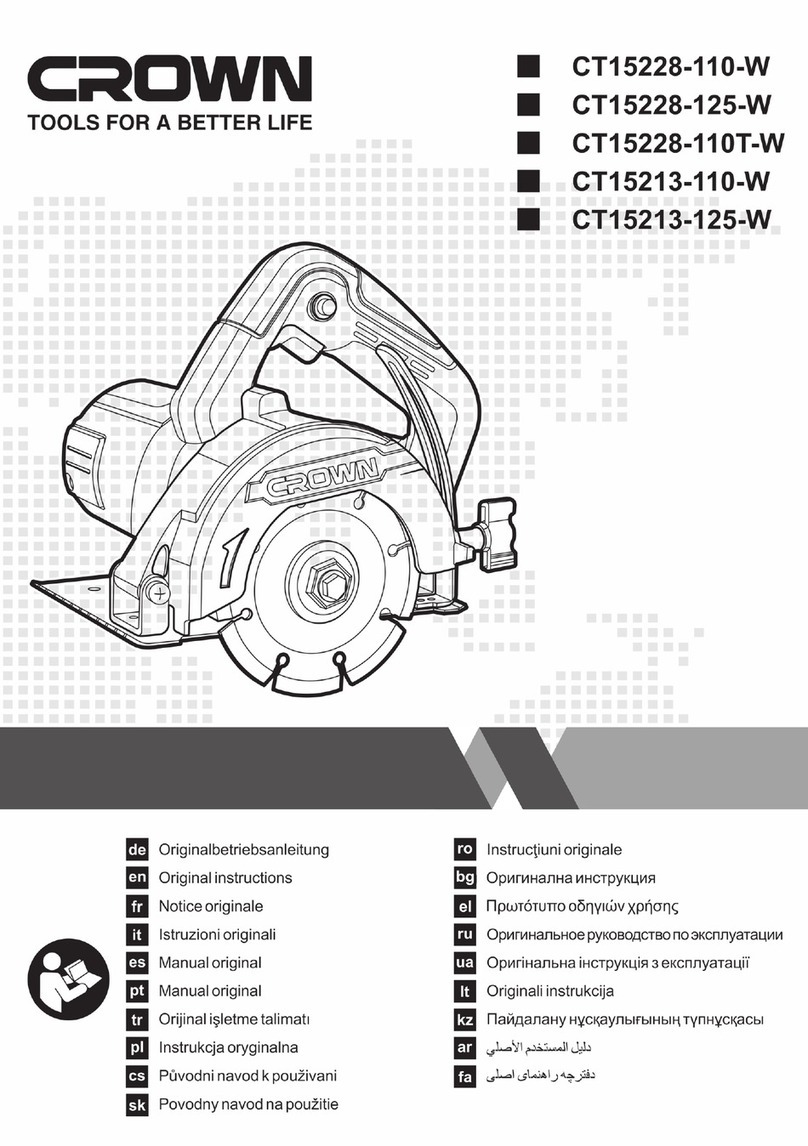
Crown
Crown CT15228-110-W Original instructions

Chicago Electric
Chicago Electric 98194 Set up and operating instructions
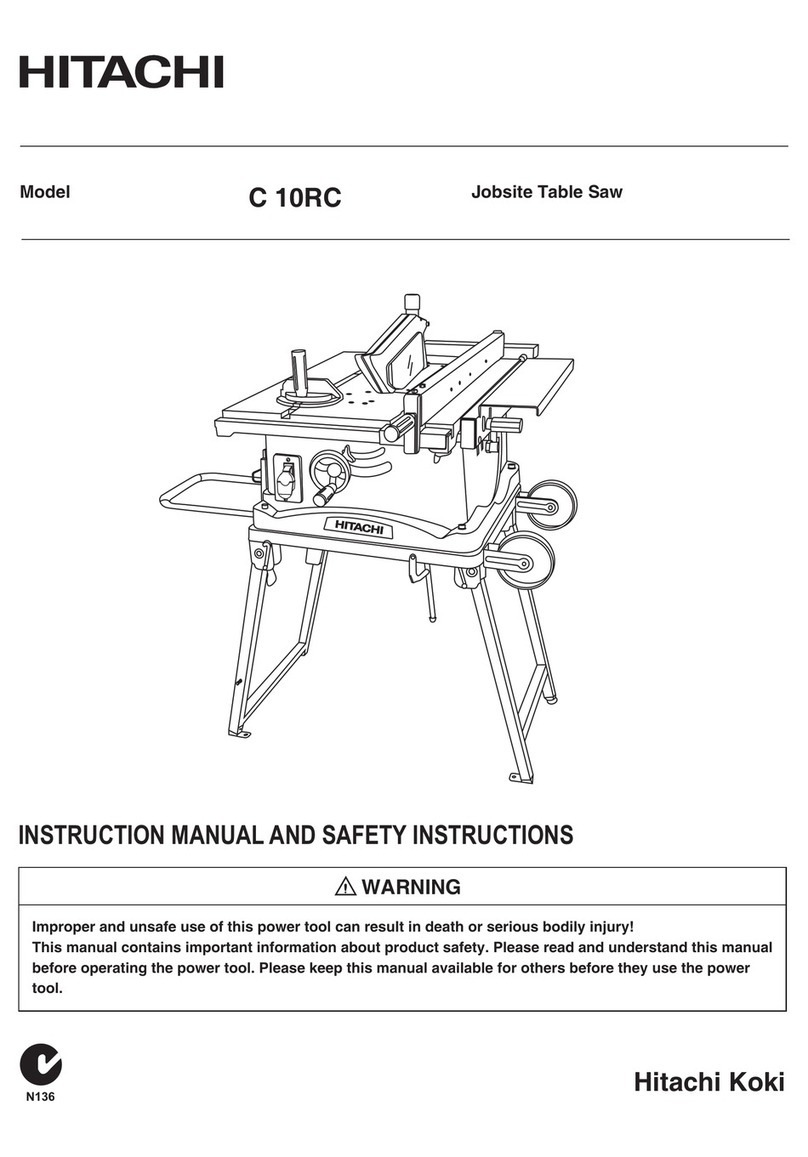
Hitachi
Hitachi C 10RC Instruction manual and safety instructions
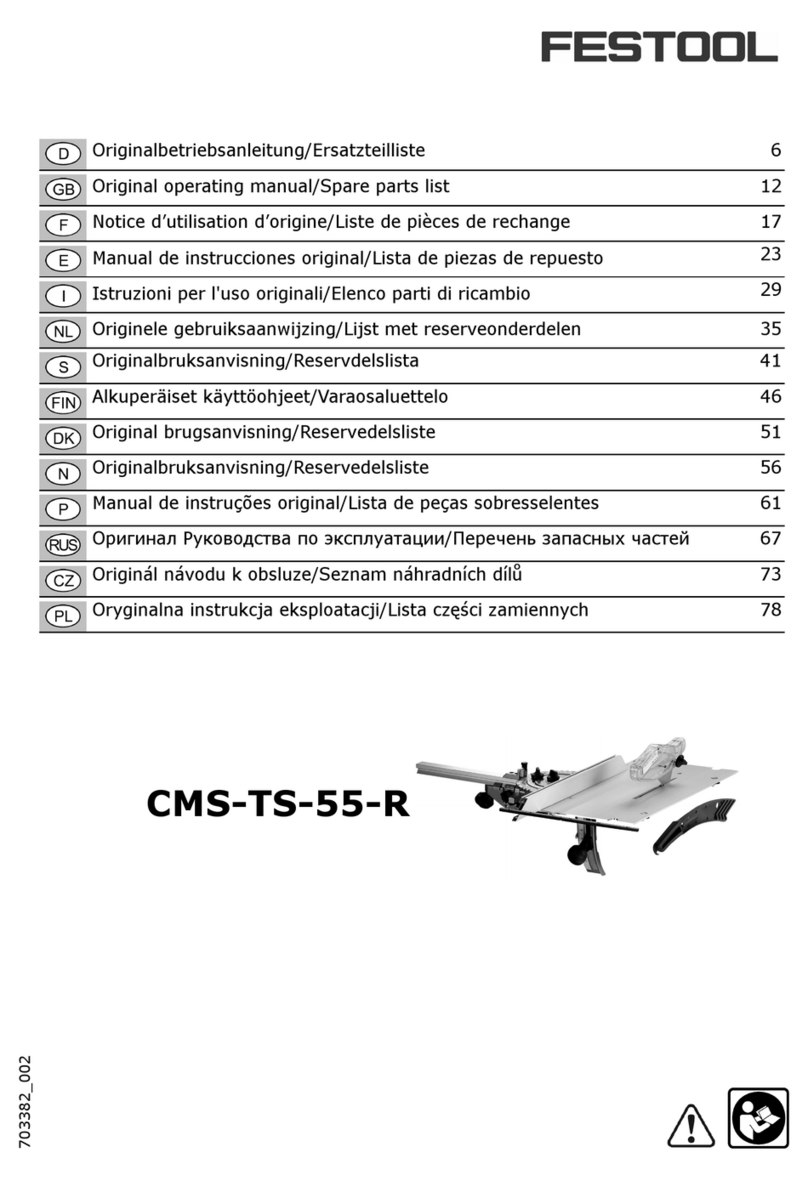
Festool
Festool CMS-TS-55-R Original operating manual/spare parts list

Husqvarna
Husqvarna SOFF-CUT 150 Operator's manual
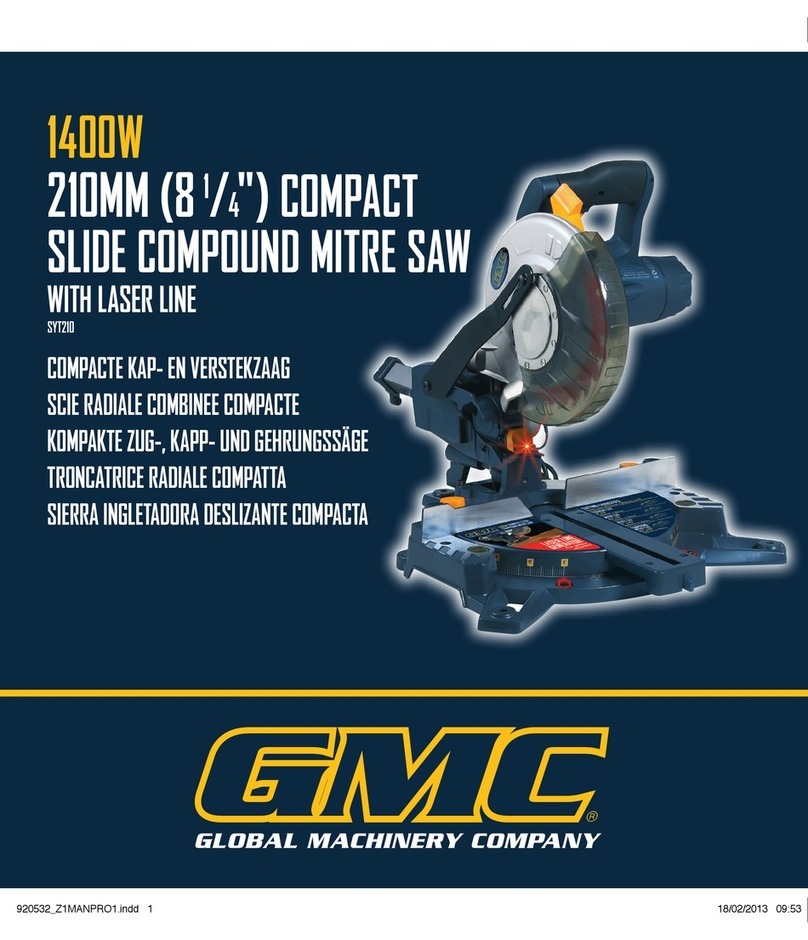
GMC
GMC SYT210 instructions
